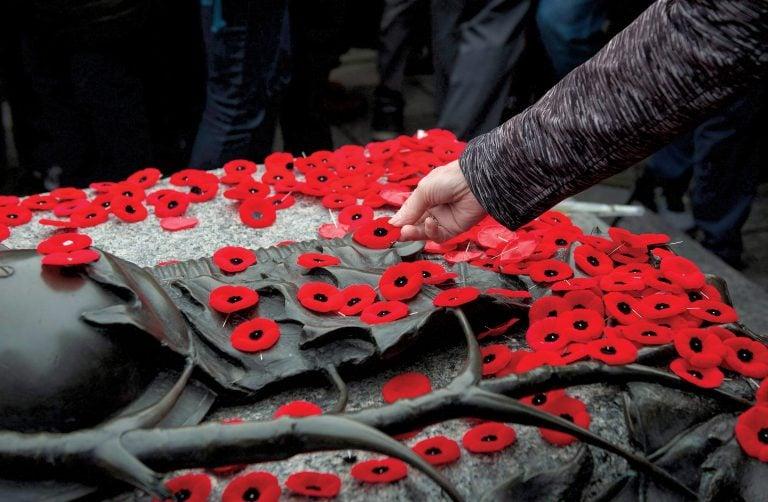Remembrance Day should be a national holiday
Our editorial: There is something beautiful in stopping work at 11 a.m. and standing at our desks in silence. But we can do better.

People place poppies on the Tomb of the Unknown Soldier at the National War Memorial in Ottawa (Justin Tang/CP)
Share
The most moving sound at Remembrance Day ceremonies, to our minds, is not the long-held mournful note of the Last Post—hauntingly beautiful though it is. Nor is it the scorching sound of the flypast as the planes thunder overhead, tearing through the silence.
The sound that moves the soul, always, is the muffled clap-clap-clap of mittened hands as the parade of veterans streams by. At outdoor ceremonies held at cenotaphs on November 11 across the country, we hear sustained applause for fewer veterans every year—no WWI vets remain, of course, and there are fewer WWII vets every time.
Remembrance Day has morphed since it came into being following the end of World War I, when it was called Armistice Day and combined with Thanksgiving. In the 1920s, a lobby pushed for Thanksgiving to be moved so a commemoration of remembrance could stand on its own. In 1931, November 11 was named Remembrance Day.
READ MORE: Presenting our Remembrance Day special commemorative issue
Since then, observation has ebbed and flowed. The National War Museum notes a sustained public interest in Remembrance Day ceremonies since 1995, the 50th anniversary of the end of World War II. The annual ceremony at the National War Memorial in Ottawa is attended by tens of thousands, many laying their poppies on the Tomb of the Unknown Soldier afterwards, turning the tomb red. Watching the crowd surge forward in that moment to add their poppies, it is tempting to think all is well with remembrance in the country. But as with everything from pipelines to carbon taxes, a patchwork of policy and regional interests exists even here.
While federal employees have the day off, provinces and territories determine their own statutory holidays—currently, Ontario, Quebec, Nova Scotia and Manitoba do not designate Remembrance Day as a statutory holiday, although Nova Scotia and Manitoba have enacted observance legislation that provides for some protocols. Schools are in or out, depending on the jurisdiction.
The Royal Canadian Legion is against declaring Remembrance Day a statutory holiday, arguing that children who would have participated in a ceremony at school may not have the chance. “Over time, the holiday side of the day may overtake the meaning of the day, and the tradition of pausing in our daily routine to observe a moment of silence for Fallen Veterans may be lost,” the Legion said in a brief to Parliament.
Canadians disagree. This year, a Historica Canada poll found 90 per cent of Canadians support November 11 being a national statutory holiday. (Eighty-eight per cent agreed it is important to attend Remembrance Day ceremonies while there are still World War II veterans present.*)
RELATED: Real postcards from the First World War that survived a century
On a recent afternoon at Sunnybrook’s Veterans Centre in Toronto (average age, 96), we took the question to veterans during a quiet moment before the afternoon’s entertainment started up with Sweet Caroline.
John Ferris, 94, wants a public holiday so families can attend memorials together. A sergeant in the Air Force in World War II, he attended Remembrance Day ceremonies as a boy with his father at Toronto’s city hall, and with his father again at 21, as a veteran himself, with “somewhat more of an understanding of war’s costs.”
Richard Ratcliffe, 91, wants a public holiday, too. The president of the residents’ council at Sunnybrook and a Navy lieutenant in Korea, he remembers being “up on the bridge in February, cold, nasty, snowing. You wonder: Does anyone back in Canada care that you’re out here?” He doesn’t buy the arguments against a holiday. “It’s an expression of a Canadian drive to be one; it shouldn’t be sectionalized province by province.”
Though there is indeed something beautiful in stopping work at 11 a.m. and standing at our desks in silence, we can do better.
We need to stand together instead, at the thousands of cenotaphs and memorials that dot this country, lean in against the blustery wind and nestle the children beside us for two minutes of silence. We need to do it in all provinces and territories. These dangerous times require nothing less.
EDITOR’S NOTE, Nov. 8, 2019: This article has been updated to include Historica Canada’s polling data from 2019.